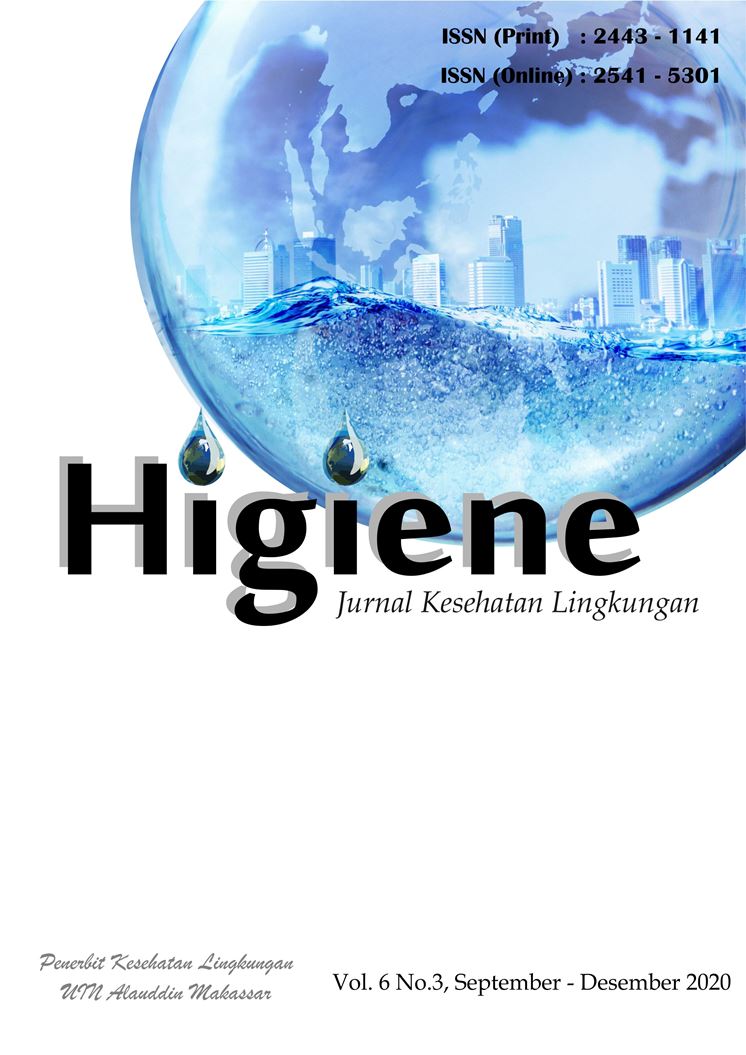Breeding Place and Resting Place Factor on DHF (Social Culture) Events In The Working Area of Pangkajene Sidrap District Maritanggae
Abstrak
Dengue Hemorrhagic Fever (DHF) or Dengue Haemorrhagic Fever (DHF) which can manifest as Dengue Shock Syndrome (DSS) is an indirect infectious disease. The mode of transmission is through the vector mosquitoes Ae.aegypti and Aedes albopictus. Based on experience to date, in general the one who plays the most role in transmission is Ae.aegypti, because of his life in and around the house; whereas Aedes albopictus in gardens, so there is less contact with humans. This study aims to determine the relationship between breeding places, resting places and socio-culture with the incidence of dengue hemorrhagic fever in the working area of Pangkajene Community Health Center, Sidrap Regency.This research is a quantitative study, and uses an observational method with a cross sectional study design. Respondents in this study were 32 research instruments using questionnaires, observation sheets and interviews, analyzed using the Chi-square test.The results showed that there was no significant relationship between the breeding place and the incidence rate of dengue with p = 0.066. DHF with p value = 0.102. Outreach to the public regarding efforts to control and mitigate DHF needs to be increased as well as increased community participation through the preservation of the mosquito nest eradication program (PSN). The problem of DHF is not only a matter of the health sector, comprehensive and multisectoral countermeasures need to be done to reduce the existing risks.
Keywords: Breeding Place, Resting Place, Socio-Culture, Incidence of DHF
Referensi
Adelia, T., Yuniar, & Dewanti. ( 2017). Hubungan Breeding Place dan Resting Place Terhadap Kejadian Demam Berdarah Dengue di Kecamatan Semarang Barat, Jurnal Kesehatan Masyarakat. Journal Kesehatan Masyarakat (e-Journal Undip), 6(6).
Anggraeni, P., & Heridadi. (2018). Faktor Resiko ( Breeding Place, Resting Place , Perilaku Kesehatan, Lingkungan dan Kebiasaan hidup) Pada Kejadian Luar Biasa Demam Berdarah Dengue di Kecamatan Cikupa Kabupaten Tangerang. Universitas Pertahanan.
Boekoesoe, D. L. (2013). Kajian Faktor Lingkungan Terhadap Kasus Demam Berdarah Dengue (DBD) Studi Kasus Di Kota Gorontalo Provinsi Gorontalo. Universitas Gorontalo.
Dini, A. M. V., Fitiany, R. N., & Wulansari, R. (2010). Faktor Iklim dan Angka Insiden Demam Berdarah Dengue (DBD) di Kabupaten Serang. Jurnal Makara Kesehatan, 14(1).
Ernawati, Bratajaya, C. N., & Martina, S. E. (2018). Gambaran Praktik Pencegahan Demam Berdarah Dengue (DBD) Di Wilayah Endemik DBD. EJournal UMM, 9(1).
Fakhriadi, R., & Asnawati. (2018). Factor-faktor yang berpengaruh terhadap keberadaan jentik aedes aegypti di kelurahan endemis dan sporadic kota Banjarbaru. Journal of Epidemiologi and Communicable Diseases, 4(1).
Kusumawardani, E. (2012). Kejadian DBD di Wilayah Pedesaan Tahun 2012 ( Daerah Perbatasan Kabupaten Bogor dan Kabupaten Lebak. Universitas Indonesia.
Marlina, H., Hayana, & Ulan, M. (2018). Analisis Aspek Lingkungan dan perilaku Keluarga Dengan Kasus Demam Berdarah Dengue (DBD) Di Kelurahan Sialangmunggu Wilayah Kerja Puskesmas Sidomulyo Kota Pekanbaru, Riau. Bhamada: Jurnal Ilmu Dan Teknologi Kesehatan, 9(2).
Marwanty, Miko, T. Y., & Wahyono.(2018). Faktor Lingkungan Rumah dan Kejadian Demam Berdarah Dengue di Kota Palopo 2016.Jurnal Epidemiologi Kesehatan Indonesia, 2.
Oroh, M. Y., Pinontoan, O. R., & B.S.Tuda, J. (2020). Faktor Lingkungan, Manusia dan Pelayanan Kesehatan Yang Berhubungan Dengan Kejadian Demam Berdarah Dengue. Journal Of Public Health and Community Medicine, 1(3).
Priesley, F., Reza, M., & Rusjdi, S. R. (2018). Hubungan Perilaku Pemberantasan Nyamuk Dengan Menutup, Menguras dan Mendaur Ulang Plus ( PSN M Plus) Terhadap Kejadian Demam Berdarah Dengue (DBD) di Kelurahan Andalas. Jurnal Kesehatan Andalas, 7(1).
Puskesmas Pangkajene. (2019). Profil Puskesmas Pangkajene 2018.
Rahmi, R., & Hasnawati. (2010). Demam Berdarah Dengue. Buletin Jendela Epidemiologi, 12.
Sopiyudin, D. (2018). Statistik Untuk Kedokteran dan Kesehatan.Epidemiologi Indonesia.
Sofia, Suhartono, Wahyuningsih,(2014) Hubungan Kondisi Rumah dan Perilaku Keluarga Dengan Kejadian Demam Berdarah Dengue di Kabupaten Aceh Besar. Jurnal Kesehatan Lingkungan Vol 13. No 1
Suryani, E. T. (2017). Gambaran Kasus Demam Berdarah Dengue di Kota Blitar Tahun 2015-2017. Jurnal Berkala Epidemiologi, 6(3).
##submission.copyrightStatement##
##submission.license.cc.by4.footer##Informasi Hak Cipta
KEBIJAKAN HIGIENE : JURNAL KESEHATAN LINGKUNGAN (AKSES TERBUKA)
Syarat yang harus dipenuhi oleh Penulis sebagai berikut:
- Penulis menyimpan hak cipta dan memberikan jurnal hak penerbitan pertama naskah secara simultan dengan lisensi di bawah Creative Commons Attribution License yang mengizinkan orang lain untuk berbagi pekerjaan dengan sebuah pernyataan kepenulisan pekerjaan dan penerbitan awal di jurnal ini.
- Penulis bisa memasukkan ke dalam penyusunan kontraktual tambahan terpisah untuk distribusi non ekslusif versi kaya terbitan jurnal (contoh: mempostingnya ke repositori institusional atau menerbitkannya dalam sebuah buku), dengan pengakuan penerbitan awalnya di jurnal ini.
- Penulis diizinkan dan didorong untuk mem-posting karya mereka online (contoh: di repositori institusional atau di website mereka) sebelum dan selama proses penyerahan, karena dapat mengarahkan ke pertukaran produktif, seperti halnya sitiran yang lebih awal dan lebih hebat dari karya yang diterbitkan. (Lihat Efek Akses Terbuka).

